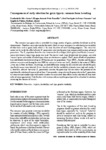Use este identificador para citar ou linkar para este item:
http://www.alice.cnptia.embrapa.br/alice/handle/doc/210424Registro completo de metadados
| Campo DC | Valor | Idioma |
|---|---|---|
| dc.contributor.author | SANTOS, V. da S. | pt_BR |
| dc.contributor.author | RAMALHO, M. A. P. | pt_BR |
| dc.contributor.author | CARNEIRO, J. E. de S. | pt_BR |
| dc.contributor.author | ABREU, A. de F. B. | pt_BR |
| dc.date.accessioned | 2013-03-22T23:30:56Z | - |
| dc.date.available | 2013-03-22T23:30:56Z | - |
| dc.date.created | 2002-09-05 | pt_BR |
| dc.date.issued | 2001 | pt_BR |
| dc.identifier.citation | Crop Breeding and Applied Biotechnology, v. 1, n. 4, p. 347-354, Dec. 2001. | pt_BR |
| dc.identifier.uri | http://www.alice.cnptia.embrapa.br/alice/handle/doc/210424 | pt_BR |
| dc.description | The common bean grain color is controlled by a large number of genes, probably distributed in all the chromosomes. Therefore, early selection for this trait is likely to cause an expressive reduction in the variability of other traits such as grain yield, which is the main objective of most breeding programs. This study was carried out to verify the effect of early (F2 generation) selection for grain type on grain yield in more advanced generations. The F2 population from the cross between the Ouro Negro (black grains) and Pérola (?carioca? - cream with brown stripes) type grains was used. The harvest seeds were divided into two groups, one with ?carioca? grains and another of mixed type, where no selection was applied. The F3 plants of both sub-populations were individually harvested resulting in 199 families per sub-populations. These 398 F3:4 families and the parent cultivars were assessed during the year 2000 dry season in Lavras and the F3:5 families in the winter of 2000 in Lavras and in Patos de Minas. On average, no yield differences among the non-selected and selected for grain type family means were detected. It was also observed that the heritability estimates were high and similar. It is, therefore, inferred that early (F2 generation) selection for grain type did not reduce the potential of the population for selection of superior inbred lines. Consequently, strong selection for grain color in the F2 generation, to screen out undesirable types will enable breeders to concentrate their efforts on the selection of other traits in the advanced generations. Only families with commercially acceptable grain type will be submitted to selection, increasing the chances of success. | pt_BR |
| dc.language.iso | eng | eng |
| dc.rights | openAccess | eng |
| dc.title | Consequences of early selection for grain type in common bean breeding. | pt_BR |
| dc.type | Artigo de periódico | pt_BR |
| dc.date.updated | 2013-03-22T23:30:56Z | pt_BR |
| dc.subject.thesagro | Feijão | pt_BR |
| dc.subject.thesagro | Grão | pt_BR |
| dc.subject.thesagro | Genética | pt_BR |
| dc.subject.thesagro | Phaseolus Vulgaris | pt_BR |
| dc.subject.thesagro | Seleção | pt_BR |
| dc.subject.thesagro | Semente | pt_BR |
| dc.subject.thesagro | Melhoramento Genético Vegetal | eng |
| riaa.ainfo.id | 210424 | pt_BR |
| riaa.ainfo.lastupdate | 2013-03-22 | pt_BR |
| dc.contributor.institution | VANDERLEI DA SILVA SANTOS, UFLA; MAGNO ANTONIO PATTO RAMALHO, UFLA; JOSE EUSTAQUIO DE SOUZA CARNEIRO, UFV; ANGELA DE FATIMA BARBOSA ABREU, CNPAF. | pt_BR |
| Aparece nas coleções: | Artigo em periódico indexado (CNPAF)  | |
Arquivos associados a este item:
| Arquivo | Descrição | Tamanho | Formato | |
|---|---|---|---|---|
| Santos1cbab.pdf | 35,81 kB | Adobe PDF |  Visualizar/Abrir |









